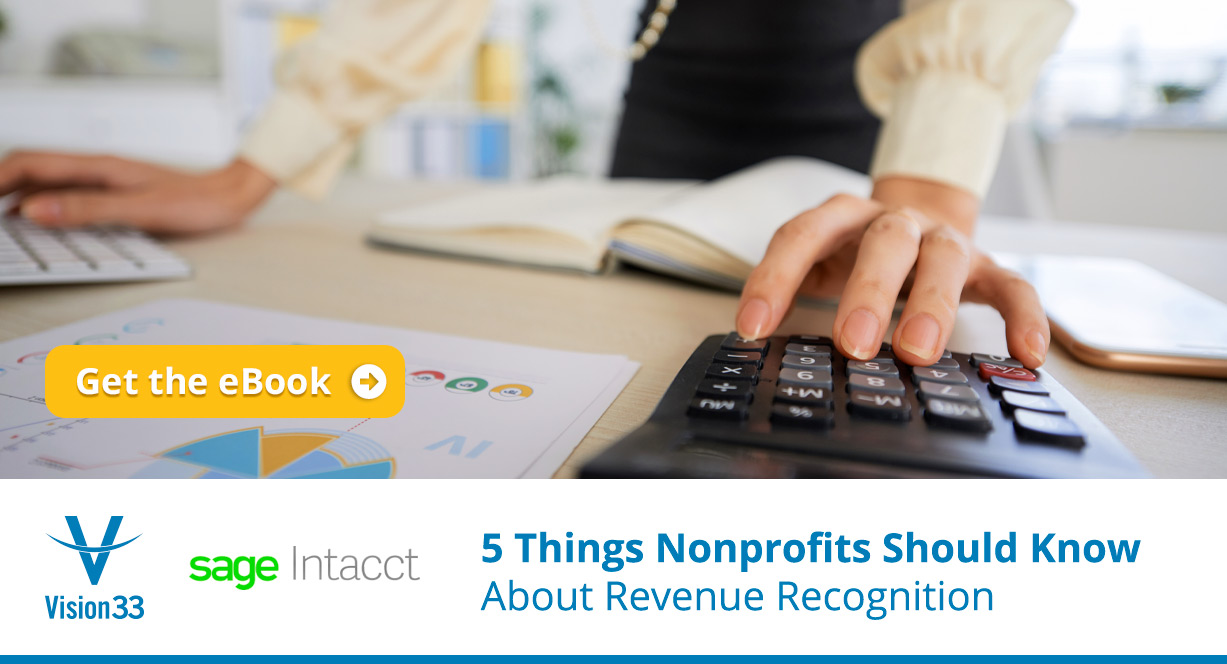Vision33 Ranked on Accounting Today’s VAR 100 List For 15th Consecutive Year
SAP Business OneThe publication’s editorial team ranks the top resellers of accounting software based on their...

February 25, 2021
Blog > 5 Things Nonprofits Should Know About Revenue Recognition
Recently, the Financial Accounting Standards Board (FASB) updated its revenue recognition guidelines. We know your nonprofit organization is doing great things, and we want to help you keep your focus on fulfilling your mission. We’ve written this blog to discuss these updates – since they’re the most significant changes to nonprofit accounting in recent history – and tell you we can help you automate and simplify revenue recognition with Sage Intacct.
The changes to revenue recognition standards mean nonprofit organizations with diverse revenue sources should take a fresh look at their internal accounting processes. Both ASU 2018-08 and ASC Topic 606 (discussed below) require your finance team to assess how it accounts for revenue and apply compliant practices, especially if your nonprofit has a material deferred revenue amount outstanding at year-end.
Here are five things you need to know about nonprofit revenue recognition.
With ASC Topic 606, FASB seeks to bring U.S. Generally Accepted Accounting Principles (GAAP) standards for revenue recognition into closer alignment with international standards (IRFS) to achieve better clarity and consistency in treatment across nations, industries, and markets. ASU 2018-08 improves the scope and previous guidance (from ASU 2014-09) around revenue from contributions.
The updated nonprofit revenue recognition standards affect revenue streams and require finance teams to apply greater judgment.
Some nonprofit organizations will be more affected than others. For example, if your nonprofit receives government grants, grant payments may represent exchange transactions or contributions.
The new guidance standardizes grant classification across nonprofit sectors that tend to rely heavily on grants and contracts, including colleges and universities, research institutions, and social services organizations.
Nonprofit finance teams must analyze and understand the updated standards to apply the correct judgments about each revenue stream in their accounting and disclosures.
Refer to FASB Clarification & Guidance for more information.
The first step to compliance is having conversations with your organization’s leadership to ensure everyone understands how the financial statements may change.
Consider following this process when implementing the new revenue recognition guidance:
There are two things to consider when grading revenue streams: materiality and timing.
Materiality matters for grading revenue streams and being required to defer, so it should be the first thing you consider when applying revenue recognition guidance.
Once you establish materiality, consider revenue timing, which is relative to your year-end. If you receive and use the funds within the year, you needn’t worry about deferrals.
Follow these steps:
If your nonprofit organization uses a small business accounting application, it may not be up to properly tracking revenue recognition. Manually updating piles of spreadsheets is a time-consuming, error-prone process.
Fortunately, there’s a better way. It starts with Sage Intacct, a modern, born-in-the-cloud financial management system. Sage Intact Revenue Recognition for Nonprofits is a Sage Intacct tool that automates the revenue recognition process and centralizes revenue recognition inside the accounting system.
With this powerful tool, your nonprofit organization can track and account for non-exchange revenue like conditional grants and contributions and exchange revenue transactions like tuition in one easy-to-use system.
By combining the centralizing of information with Sage Intacct’s automated revenue recognition, you’ll improve visibility into conditions and restrictions and gain meaningful insights about your organization’s revenue. You’ll also save time, so you can focus more energy on fulfilling your nonprofit organization’s mission.
To learn more about Sage Intacct Revenue Recognition and how you can automate revenue recognition for better compliance, download the free Nonprofit Revenue Recognition Simplified eBook.
Subscribe to our newsletter to receive our latest blog posts, case studies and ERP news delivered straight to your inbox.
The publication’s editorial team ranks the top resellers of accounting software based on their...
These businesses can effortlessly track profitability by customer, improve timekeeping and payment...
Subscription businesses need a powerful financial management system. Find out why Sage Intacct for...
Recieve our latest blog posts, case studies, and ERP news
delivered straight to your inbox.